7月,美國新增就業(yè)180萬人,,是史上單月就業(yè)增長幅度最高的月份之一,,總就業(yè)人數(shù)達到1.396億人。雖然這與4月的1.303億就業(yè)人口相比進步顯著,,但依舊遠低于2月的1.525億人,。
簡而言之:就業(yè)市場正在好轉(zhuǎn),,但形勢依舊非常糟糕。
而且就業(yè)市場的恢復(fù)速度注定會放緩,。過去幾個月,,招聘數(shù)量增加主要源自各州美甲店和牙科診所等商戶的復(fù)工,這些商戶不會吸引大量人群聚集,。但除非我們找到抑制病毒的方法,,否則無法完全復(fù)工的公司,比如游樂園,、游艇公司和酒吧等,,會拖累經(jīng)濟的全面復(fù)蘇。
美國經(jīng)濟還面臨著一系列障礙:美國近3,000萬失業(yè)人口領(lǐng)取的每周600美元聯(lián)邦疫情補助到期,,將導(dǎo)致消費者支出(占美國經(jīng)濟的三分之二)減少,,而即將到來的企業(yè)和家庭破產(chǎn)會引發(fā)金融危機。與3月份通過2.2萬億美元《冠狀病毒援助,、救濟和經(jīng)濟安全法案》(CARES Act)時不同,,這一次,民主黨和共和黨的領(lǐng)導(dǎo)人都不愿意在有關(guān)更多經(jīng)濟刺激措施的交鋒中讓步,。
為了幫助《財富》雜志的讀者更好地了解美國經(jīng)濟的現(xiàn)狀和未來趨勢,,我們根據(jù)一直在密切跟蹤的疫情期間的經(jīng)濟數(shù)據(jù),制作了9張數(shù)據(jù)圖:
失業(yè)率

在3月停工之后,美國遭遇了史上最大幅度的經(jīng)濟收縮:失業(yè)率從2月的3.5%(50年最低)到激增到4月的14.7%,,達到1940年以來的最高水平,。
之后就業(yè)市場開始復(fù)蘇,恢復(fù)的速度超過了許多經(jīng)濟學(xué)家的預(yù)期,。失業(yè)率從6月的11.1%到下降到7月的10.2%,。這超出了國會預(yù)算辦公室(Congressional Budget Office)在5月的預(yù)期。當(dāng)時,,該辦公室預(yù)測失業(yè)率在2021年底將達到9.5%,。
但進入夏季之后,就業(yè)增長幅度有所放緩,。美國6月新增480萬個就業(yè)崗位,,但7月只增加了180萬個。
國內(nèi)生產(chǎn)總值
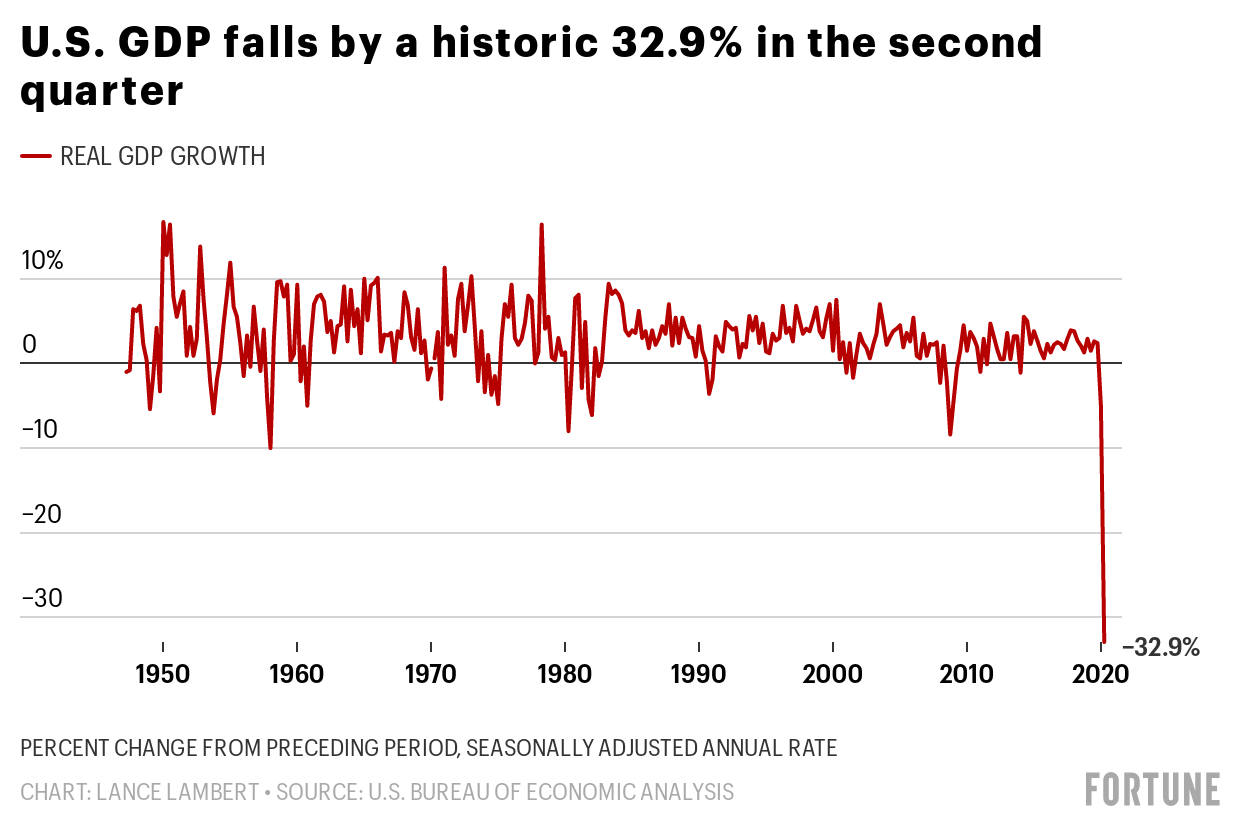
據(jù)美國經(jīng)濟分析局(U.S. Bureau of Economic Analysis)統(tǒng)計,,從4月至6月,,美國第二季度的實際GDP較前一季度下跌32.9%,。這是自1947年以來美國GDP單季度最大降幅,也意味著美國經(jīng)濟產(chǎn)出因為新冠疫情已經(jīng)損失了超過1萬億美元,。
在此之前,,美國第一季度的GDP已經(jīng)下跌了5%。第一季度在最后幾周才爆發(fā)了新冠疫情,。但經(jīng)濟學(xué)家認為最糟糕的情況遠沒有結(jié)束,。事實上,高盛(Goldman Sachs)預(yù)測隨著各州紛紛復(fù)工,,第三季度的GDP漲幅將達到創(chuàng)紀錄的25%,。即便如此,今年美國GDP的跌幅將依舊高達4.6%,。
各州失業(yè)率
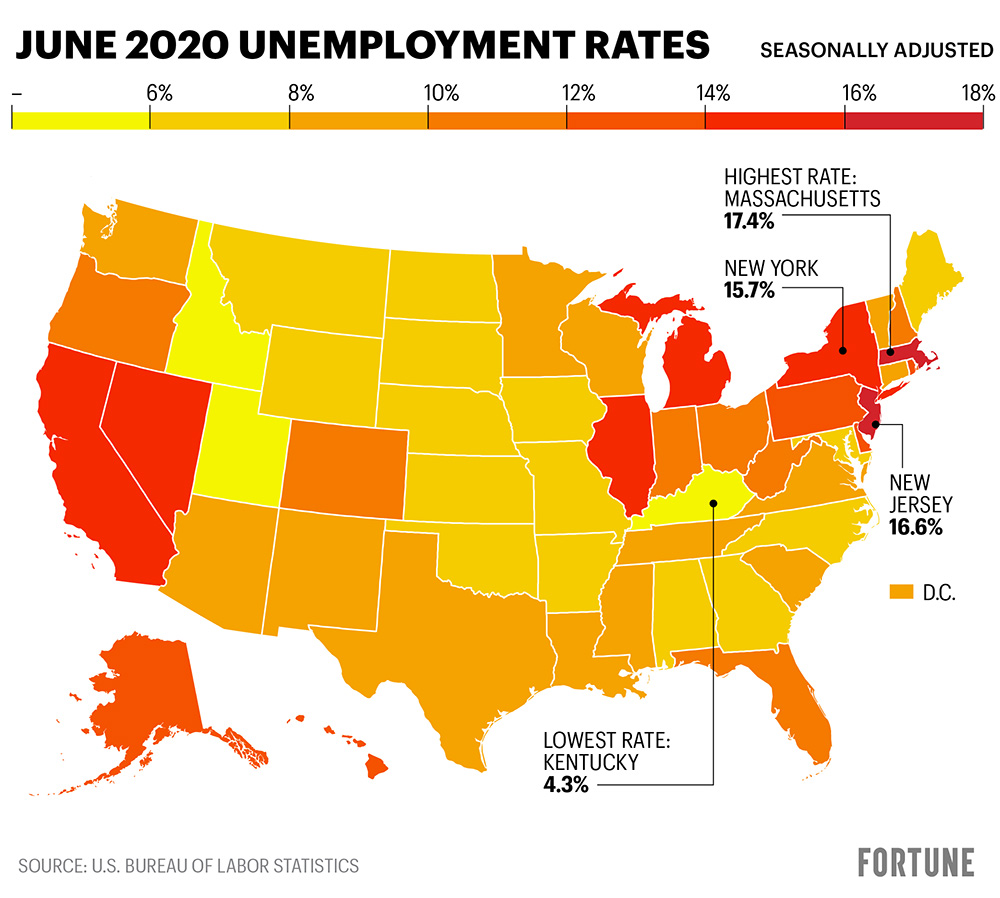
部分州的經(jīng)濟已經(jīng)開始呈V字型復(fù)蘇,,但有些州的失業(yè)率仍然處在大蕭條時期的水平。
據(jù)美國勞工統(tǒng)計局統(tǒng)計,,肯塔基州的季節(jié)調(diào)整后失業(yè)率從2月的4.2%迅速升高到4月的16.6%,。但隨著該州州長安德魯?貝希爾宣布“藍草州”經(jīng)濟重啟,該州6月的失業(yè)率降至4.3%,,為美國最低,。
猶他州(5.1%)、愛達荷州(5.6%)和北達科他州(6.1%)等較偏遠州的失業(yè)率,,也表現(xiàn)出V字型復(fù)蘇的趨勢,。包括肯塔基州在內(nèi),這些州并不過度依賴慘遭疫情破壞的休閑餐旅行業(yè),。而且這些州有更多經(jīng)濟部門已經(jīng)復(fù)工,。
也有一些地區(qū)絲毫沒有復(fù)蘇的跡象。新澤西州4月的失業(yè)率為16.3%,,到6月提高到了16.6%,。紐約州和新澤西州等東北部各州是早期的疫情震中,這些州的經(jīng)濟重啟速度更加緩慢,。
CEO的展望
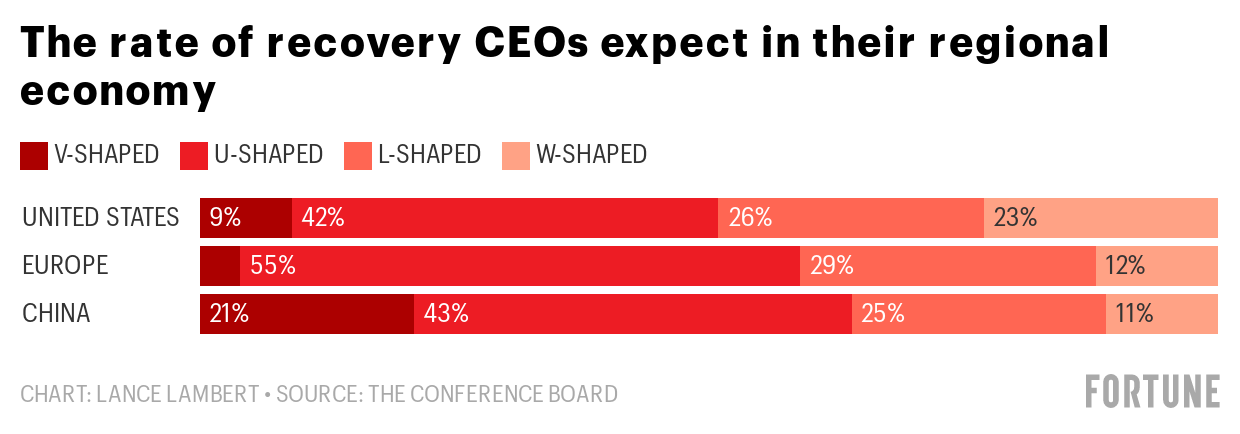
42%的美國CEO預(yù)測經(jīng)濟將出現(xiàn)U字型復(fù)蘇,即更加溫和的反彈,,26%預(yù)測會出現(xiàn)可怕的L字型復(fù)蘇,,23%認為美國經(jīng)濟將經(jīng)歷W字型復(fù)蘇或者二次探底。美國經(jīng)濟咨商會(Conference Board)近期的CEO調(diào)查顯示,,只有9%的美國CEO預(yù)測美國經(jīng)濟反彈的速度將與萎縮的速度相當(dāng),,即會出現(xiàn)V字型反彈。
消極的經(jīng)濟展望意味著CEO們不太可能開展商業(yè)投資,,這將放緩經(jīng)濟復(fù)蘇的速度,。
新冠肺炎確診病例
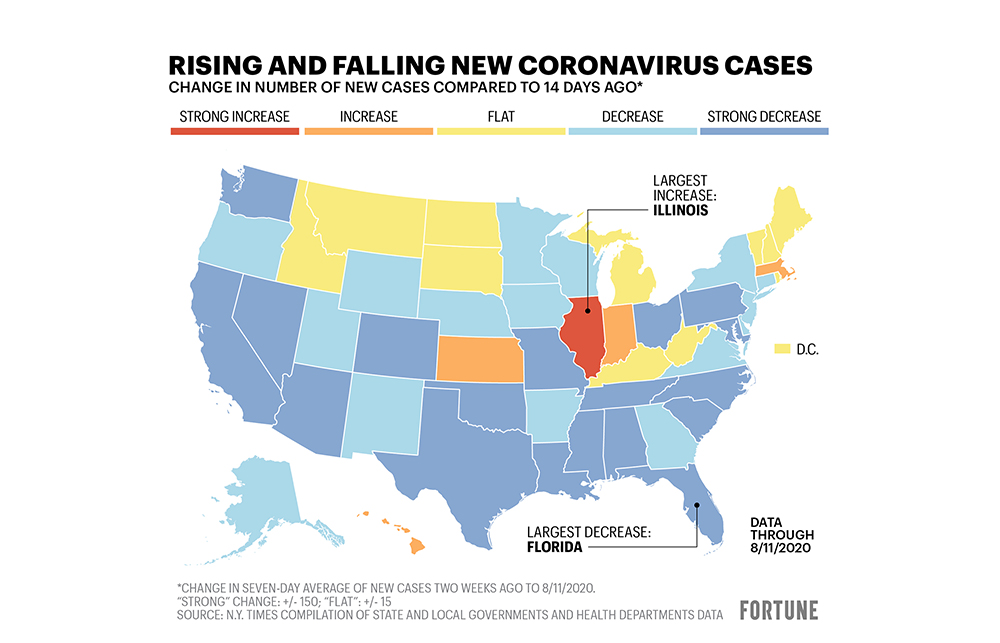
過去幾周,美國南部,、西部和中西部的新冠肺炎病例迅速增加,。但《財富》雜志分析《紐約時報》本周的數(shù)據(jù)發(fā)現(xiàn),與兩周前相比,,18個州連續(xù)七天的平均每日新增病例至少減少了150例,。病例減少幅度最大的是佛羅里達州和亞利桑那州。
新冠肺炎病例減少讓我們看到了希望,,代表美國不會因為最近的疫情再次陷入經(jīng)濟衰退,。
首次申領(lǐng)失業(yè)補助金的人數(shù)
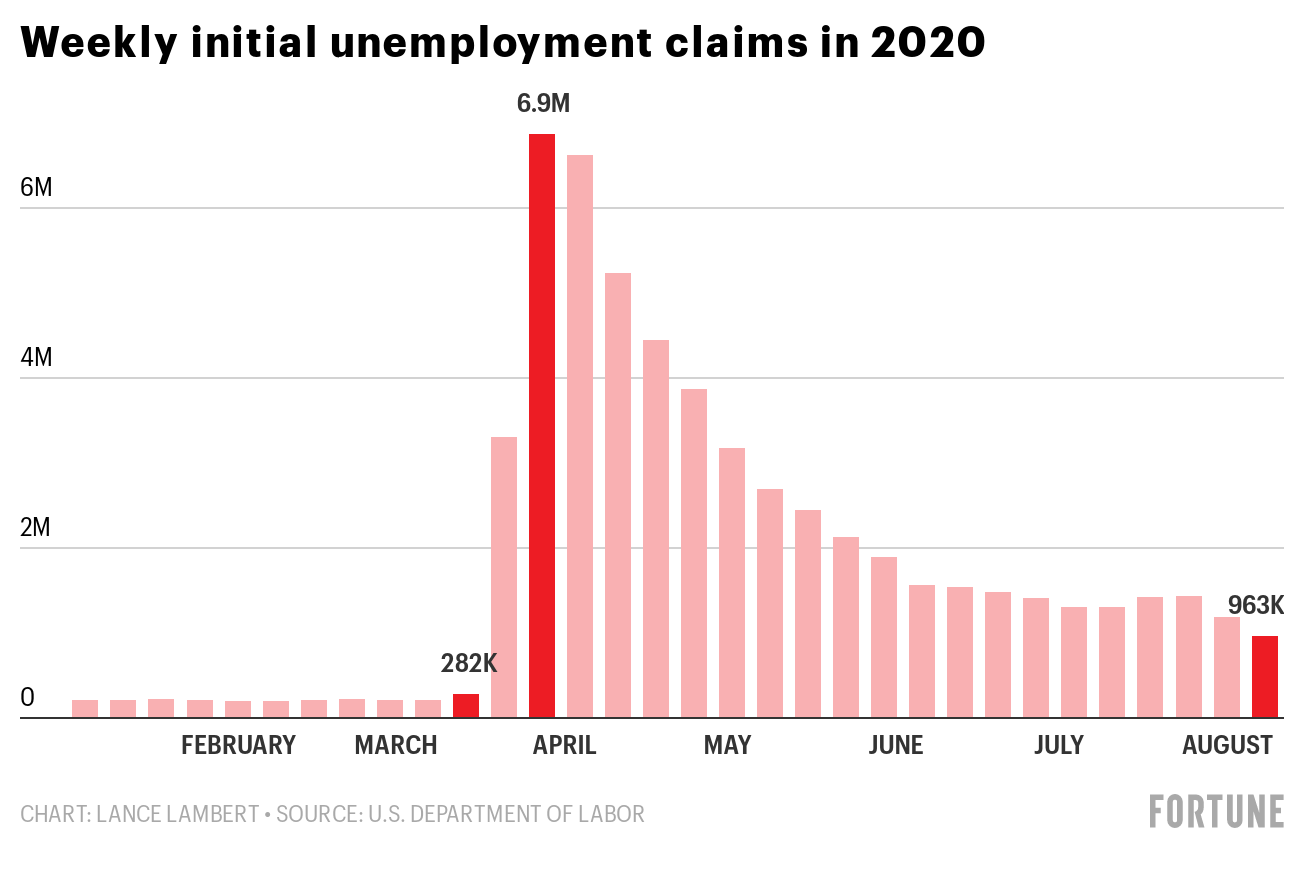 、
、我們在周四獲悉,,單周首次申領(lǐng)失業(yè)補助金的人數(shù)自疫情爆發(fā)以來第一次低于100萬人。但96.3萬首次申領(lǐng)失業(yè)補助的人數(shù),,依舊是疫情爆發(fā)之前的三倍以上,。
這意味著盡管經(jīng)濟持續(xù)復(fù)蘇,但雇主依舊在裁員,。與封城期間的春季裁員或臨時解雇不同,,這些裁員通常是被永久性解雇。
美國領(lǐng)取失業(yè)補助金的人數(shù)

截至8月1日的一周內(nèi),美國目前申領(lǐng)失業(yè)補助金或持續(xù)申領(lǐng)失業(yè)補助的總?cè)藬?shù)為1,550萬人,。這與截至5月9日的一周內(nèi)的最高峰2,490萬人相比已經(jīng)大幅減少,,但與3月初的180萬失業(yè)人口相比仍有巨大差距。
坦白的說,,美國目前處在大規(guī)模失業(yè)階段,,要走出困境可能需要幾年時間,。
從7月25日開始,,這1,550萬美國失業(yè)人口以及領(lǐng)取疫情失業(yè)援助救濟或疫情緊急失業(yè)補助的1,190萬人,不能再額外領(lǐng)取600美元失業(yè)補助金,。美國總統(tǒng)唐納德?特朗普上周簽署了一份備忘錄,,提出向領(lǐng)取州失業(yè)補助的人員每周額外發(fā)放300美元補貼,但我們并不知道這筆資金從什么時候開始發(fā)放以及他的行政命令是否合法,。
制造業(yè)
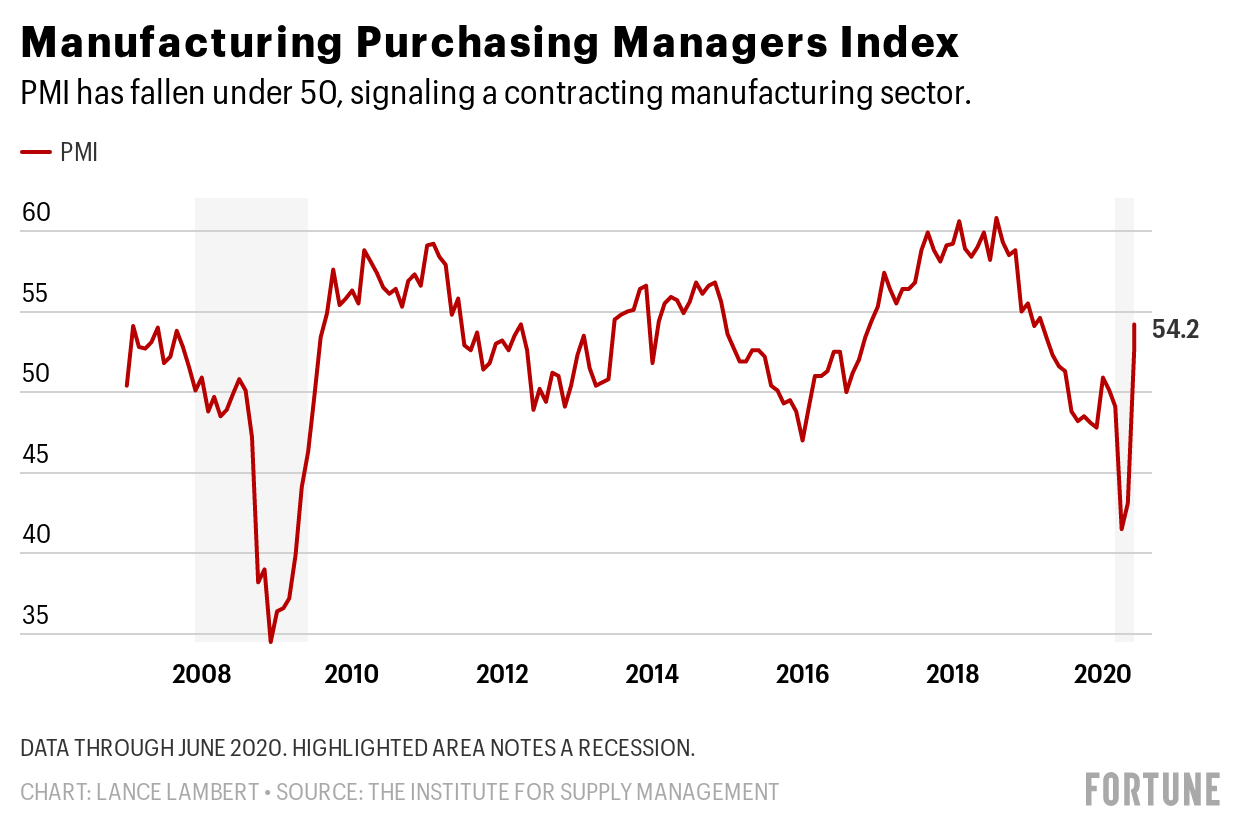
大衰退令建筑業(yè)和制造業(yè)遭遇重創(chuàng),。但這一次,,仍然處在競價戰(zhàn)當(dāng)中的房地產(chǎn)行業(yè)和制造業(yè)成為經(jīng)濟中的亮點。6月,,供應(yīng)管理協(xié)會(Institute for Supply Management)的采購經(jīng)理人指數(shù)(PMI)從4月的41.5和5月的52.6提高到54.2,。由于PMI指數(shù)低于50才意味著制造業(yè)正在萎縮,因此這表明美國制造業(yè)正在恢復(fù)增長,。
春季的工廠停工造成汽車,、木材、硬幣,、胡椒博士(Dr Pepper)飲品等各種物資短缺,。近期內(nèi),制造商將忙于填補這些空缺,。
休閑餐旅行業(yè)的就業(yè)
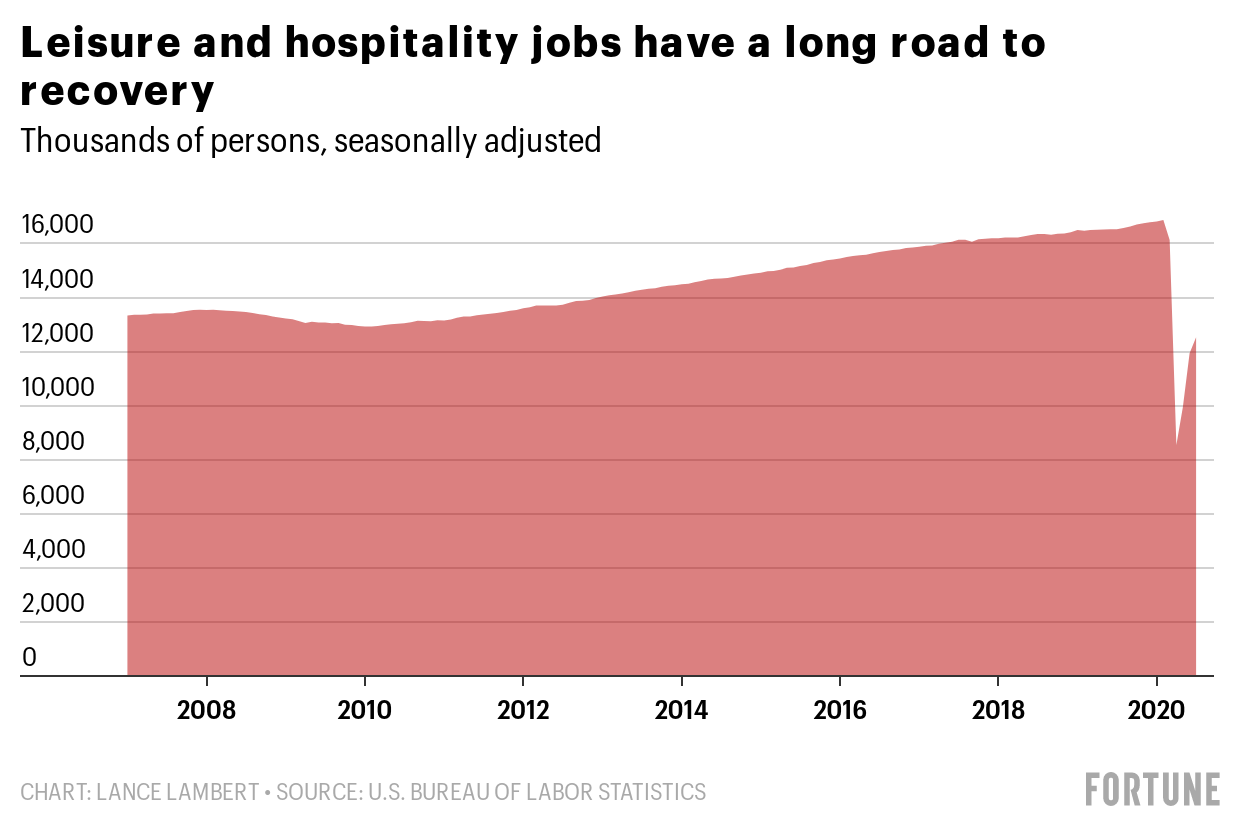
新冠疫情使旅游業(yè)和服務(wù)業(yè)的就業(yè)損失慘重。事實上,,美國休閑餐旅業(yè)的就業(yè)崗位從2月的1,690萬個減少到4月的850萬個,,已經(jīng)低于該行業(yè)1989年的就業(yè)人數(shù)(900萬人)。
雖然休閑餐旅業(yè)的就業(yè)崗位已經(jīng)恢復(fù)到1,250萬個,,但仍然無法達到2020年2月的水平,,甚至還有很大差距,除非病毒得到抑制,,并且全國恢復(fù)正常出行,。
綜合來看,這9張圖告訴了我們哪些信息,?顯然,,在5月各州經(jīng)濟重啟之后,經(jīng)濟進入了復(fù)蘇軌道,,但經(jīng)濟復(fù)蘇的速度正在放緩,。而經(jīng)濟復(fù)蘇速度放緩是由于財政刺激措施到期,企業(yè)破產(chǎn)數(shù)量開始增加,。
穆迪分析(Moody’s Analytics)的首席經(jīng)濟學(xué)家馬克?扎蒂告訴《財富》雜志:“美國的經(jīng)濟狀況開始日益糟糕……沒有600美元額外失業(yè)補助,,沒有更多薪資保護計劃,沒有各州和地方政府的幫助,,我們將跌入財務(wù)懸崖,。我認為有效的疫苗是經(jīng)濟恢復(fù)運行的必要條件,疫苗上市的時間越長,,我們就越有可能重新陷入衰退,,甚至出現(xiàn)大蕭條這樣更糟糕的情況。”(財富中文網(wǎng))
譯者:Biz
7月,,美國新增就業(yè)180萬人,,是史上單月就業(yè)增長幅度最高的月份之一,總就業(yè)人數(shù)達到1.396億人,。雖然這與4月的1.303億就業(yè)人口相比進步顯著,,但依舊遠低于2月的1.525億人。
簡而言之:就業(yè)市場正在好轉(zhuǎn),,但形勢依舊非常糟糕,。
而且就業(yè)市場的恢復(fù)速度注定會放緩。過去幾個月,,招聘數(shù)量增加主要源自各州美甲店和牙科診所等商戶的復(fù)工,,這些商戶不會吸引大量人群聚集。但除非我們找到抑制病毒的方法,,否則無法完全復(fù)工的公司,,比如游樂園、游艇公司和酒吧等,,會拖累經(jīng)濟的全面復(fù)蘇,。
美國經(jīng)濟還面臨著一系列障礙:美國近3,000萬失業(yè)人口領(lǐng)取的每周600美元聯(lián)邦疫情補助到期,將導(dǎo)致消費者支出(占美國經(jīng)濟的三分之二)減少,,而即將到來的企業(yè)和家庭破產(chǎn)會引發(fā)金融危機,。與3月份通過2.2萬億美元《冠狀病毒援助、救濟和經(jīng)濟安全法案》(CARES Act)時不同,,這一次,,民主黨和共和黨的領(lǐng)導(dǎo)人都不愿意在有關(guān)更多經(jīng)濟刺激措施的交鋒中讓步。
為了幫助《財富》雜志的讀者更好地了解美國經(jīng)濟的現(xiàn)狀和未來趨勢,,我們根據(jù)一直在密切跟蹤的疫情期間的經(jīng)濟數(shù)據(jù),,制作了9張數(shù)據(jù)圖:
失業(yè)率
在3月停工之后,美國遭遇了史上最大幅度的經(jīng)濟收縮:失業(yè)率從2月的3.5%(50年最低)到激增到4月的14.7%,,達到1940年以來的最高水平,。
之后就業(yè)市場開始復(fù)蘇,恢復(fù)的速度超過了許多經(jīng)濟學(xué)家的預(yù)期,。失業(yè)率從6月的11.1%到下降到7月的10.2%,。這超出了國會預(yù)算辦公室(Congressional Budget Office)在5月的預(yù)期。當(dāng)時,,該辦公室預(yù)測失業(yè)率在2021年底將達到9.5%,。
但進入夏季之后,,就業(yè)增長幅度有所放緩,。美國6月新增480萬個就業(yè)崗位,但7月只增加了180萬個,。
國內(nèi)生產(chǎn)總值
據(jù)美國經(jīng)濟分析局(U.S. Bureau of Economic Analysis)統(tǒng)計,,從4月至6月,,美國第二季度的實際GDP較前一季度下跌32.9%。這是自1947年以來美國GDP單季度最大降幅,,也意味著美國經(jīng)濟產(chǎn)出因為新冠疫情已經(jīng)損失了超過1萬億美元,。
在此之前,美國第一季度的GDP已經(jīng)下跌了5%,。第一季度在最后幾周才爆發(fā)了新冠疫情,。但經(jīng)濟學(xué)家認為最糟糕的情況遠沒有結(jié)束。事實上,,高盛(Goldman Sachs)預(yù)測隨著各州紛紛復(fù)工,,第三季度的GDP漲幅將達到創(chuàng)紀錄的25%。即便如此,,今年美國GDP的跌幅將依舊高達4.6%,。
各州失業(yè)率
部分州的經(jīng)濟已經(jīng)開始呈V字型復(fù)蘇,但有些州的失業(yè)率仍然處在大蕭條時期的水平,。
據(jù)美國勞工統(tǒng)計局統(tǒng)計,,肯塔基州的季節(jié)調(diào)整后失業(yè)率從2月的4.2%迅速升高到4月的16.6%。但隨著該州州長安德魯?貝希爾宣布“藍草州”經(jīng)濟重啟,,該州6月的失業(yè)率降至4.3%,,為美國最低。
猶他州(5.1%),、愛達荷州(5.6%)和北達科他州(6.1%)等較偏遠州的失業(yè)率,,也表現(xiàn)出V字型復(fù)蘇的趨勢。包括肯塔基州在內(nèi),,這些州并不過度依賴慘遭疫情破壞的休閑餐旅行業(yè),。而且這些州有更多經(jīng)濟部門已經(jīng)復(fù)工。
也有一些地區(qū)絲毫沒有復(fù)蘇的跡象,。新澤西州4月的失業(yè)率為16.3%,,到6月提高到了16.6%。紐約州和新澤西州等東北部各州是早期的疫情震中,,這些州的經(jīng)濟重啟速度更加緩慢,。
CEO的展望
42%的美國CEO預(yù)測經(jīng)濟將出現(xiàn)U字型復(fù)蘇,即更加溫和的反彈,,26%預(yù)測會出現(xiàn)可怕的L字型復(fù)蘇,,23%認為美國經(jīng)濟將經(jīng)歷W字型復(fù)蘇或者二次探底。美國經(jīng)濟咨商會(Conference Board)近期的CEO調(diào)查顯示,,只有9%的美國CEO預(yù)測美國經(jīng)濟反彈的速度將與萎縮的速度相當(dāng),,即會出現(xiàn)V字型反彈。
消極的經(jīng)濟展望意味著CEO們不太可能開展商業(yè)投資,這將放緩經(jīng)濟復(fù)蘇的速度,。
新冠肺炎確診病例
過去幾周,,美國南部、西部和中西部的新冠肺炎病例迅速增加,。但《財富》雜志分析《紐約時報》本周的數(shù)據(jù)發(fā)現(xiàn),,與兩周前相比,18個州連續(xù)七天的平均每日新增病例至少減少了150例,。病例減少幅度最大的是佛羅里達州和亞利桑那州,。
新冠肺炎病例減少讓我們看到了希望,代表美國不會因為最近的疫情再次陷入經(jīng)濟衰退,。
首次申領(lǐng)失業(yè)補助金的人數(shù)
我們在周四獲悉,,單周首次申領(lǐng)失業(yè)補助金的人數(shù)自疫情爆發(fā)以來第一次低于100萬人。但96.3萬首次申領(lǐng)失業(yè)補助的人數(shù),,依舊是疫情爆發(fā)之前的三倍以上,。
這意味著盡管經(jīng)濟持續(xù)復(fù)蘇,但雇主依舊在裁員,。與封城期間的春季裁員或臨時解雇不同,,這些裁員通常是被永久性解雇。
美國領(lǐng)取失業(yè)補助金的人數(shù)
截至8月1日的一周內(nèi),,美國目前申領(lǐng)失業(yè)補助金或持續(xù)申領(lǐng)失業(yè)補助的總?cè)藬?shù)為1,550萬人,。這與截至5月9日的一周內(nèi)的最高峰2,490萬人相比已經(jīng)大幅減少,但與3月初的180萬失業(yè)人口相比仍有巨大差距,。
坦白的說,,美國目前處在大規(guī)模失業(yè)階段,要走出困境可能需要幾年時間,。
從7月25日開始,,這1,550萬美國失業(yè)人口以及領(lǐng)取疫情失業(yè)援助救濟或疫情緊急失業(yè)補助的1,190萬人,不能再額外領(lǐng)取600美元失業(yè)補助金,。美國總統(tǒng)唐納德?特朗普上周簽署了一份備忘錄,,提出向領(lǐng)取州失業(yè)補助的人員每周額外發(fā)放300美元補貼,但我們并不知道這筆資金從什么時候開始發(fā)放以及他的行政命令是否合法,。
制造業(yè)
大衰退令建筑業(yè)和制造業(yè)遭遇重創(chuàng),。但這一次,仍然處在競價戰(zhàn)當(dāng)中的房地產(chǎn)行業(yè)和制造業(yè)成為經(jīng)濟中的亮點,。6月,,供應(yīng)管理協(xié)會(Institute for Supply Management)的采購經(jīng)理人指數(shù)(PMI)從4月的41.5和5月的52.6提高到54.2。由于PMI指數(shù)低于50才意味著制造業(yè)正在萎縮,,因此這表明美國制造業(yè)正在恢復(fù)增長,。
春季的工廠停工造成汽車,、木材、硬幣,、胡椒博士(Dr Pepper)飲品等各種物資短缺。近期內(nèi),,制造商將忙于填補這些空缺,。
休閑餐旅行業(yè)的就業(yè)
新冠疫情使旅游業(yè)和服務(wù)業(yè)的就業(yè)損失慘重。事實上,,美國休閑餐旅業(yè)的就業(yè)崗位從2月的1,690萬個減少到4月的850萬個,,已經(jīng)低于該行業(yè)1989年的就業(yè)人數(shù)(900萬人)。
雖然休閑餐旅業(yè)的就業(yè)崗位已經(jīng)恢復(fù)到1,250萬個,,但仍然無法達到2020年2月的水平,,甚至還有很大差距,除非病毒得到抑制,,并且全國恢復(fù)正常出行,。
綜合來看,這9張圖告訴了我們哪些信息,?顯然,,在5月各州經(jīng)濟重啟之后,經(jīng)濟進入了復(fù)蘇軌道,,但經(jīng)濟復(fù)蘇的速度正在放緩,。而經(jīng)濟復(fù)蘇速度放緩是由于財政刺激措施到期,企業(yè)破產(chǎn)數(shù)量開始增加,。
穆迪分析(Moody’s Analytics)的首席經(jīng)濟學(xué)家馬克?扎蒂告訴《財富》雜志:“美國的經(jīng)濟狀況開始日益糟糕……沒有600美元額外失業(yè)補助,,沒有更多薪資保護計劃,沒有各州和地方政府的幫助,,我們將跌入財務(wù)懸崖,。我認為有效的疫苗是經(jīng)濟恢復(fù)運行的必要條件,疫苗上市的時間越長,,我們就越有可能重新陷入衰退,,甚至出現(xiàn)大蕭條這樣更糟糕的情況?!保ㄘ敻恢形木W(wǎng))
譯者:Biz
The U.S. economy added 1.8 million jobs in July, one of the highest one-month jumps on record, bringing total employment to 139.6 million. While that is substantial progress compared to April, when only 130.3 million were employed, it's still significantly less that the 152.5 million people who made up the U.S. paid workforce in February.
Simply put: Employment is improving, but it's still really bad.
And that rate of recovery is destined to slow. Over the past few months hiring was driven by states reopening businesses, like nail salons and dental offices, which don't attract huge crowds. But unless the virus is tamed, businesses that do and are therefore not able to fully reopen—including amusement parks, cruise lines, and bars—will hold back a broader recovery.
The economy also faces a series of headwinds: Expired $600 weekly federal pandemic assistance for around 30 million unemployed Americans threatens to drag down consumer spending—two-thirds of the economy—and looming business failures and household bankruptcies could cause a financial crisis. And unlike in March when the $2.2 trillion CARES Act was passed, this go-around Democratic and Republican leaders have thus far been unwilling to compromise on more economic stimulus.
To give Fortune readers a better understanding of where the economy is and where it’s heading, we rounded up nine charts of economic data we’ve been tracking throughout the crisis:
Jobless rate
The economic contraction following the March shutdowns was the sharpest in U.S. history: The jobless rate jumped from 3.5% in February—a 50-year low—to 14.7% in April——the highest level since 1940.
We've since shifted into a recovery that is moving faster than many economists expected. The unemployment rate dropped from 11.1% in June to 10.2% in July. That beats the timeline the Congressional Budget Office projected in May, when it forecasted a 9.5% unemployment rate at the end of 2021.
But the pace of job growth slowed during the summer. In June the economy added 4.8 million jobs, followed by 1.8 million in July.
Gross domestic product
Second quarter real GDP, in the period from April to June, declined by 32.9% from the preceding quarter, according to the U.S. Bureau of Economic Analysis. That's the largest single quarterly decline on record for data going back to 1947 and represents more than $1 trillion in economic output wiped out by the coronavirus pandemic.
That 32.9% decline follows a 5% decline in the first quarter, which only included the first few weeks of the pandemic. But economists believe the worst is over. Indeed, Goldman Sachs projects third-quarter GDP will jump a record 25%, as the economy benefits from those states that were able to reopen. But even with that rebound, GDP would still end the year down 4.6%.
State-by-state unemployment rate
The economies of some state are already seeing a V-shaped recovery, but others remain at Great Depression–era unemployment levels.
In Kentucky, the seasonally adjusted jobless rate soared from 4.2% in February to 16.6% in April, according to the U.S. Bureau of Labor Statistics. But as Gov. Andrew Beshear reopened the Bluegrass State's economy, the jobless rate sunk to 4.3% by June—the lowest in the nation.
Other more rural states like Utah (5.1%), Idaho (5.6%), and North Dakota (6.1%) have jobless rates that also indicate V-shaped recoveries. These states, including Kentucky, don'y rely heavily on industries like leisure and hospitality that were decimated by the pandemic. And they've reopened more segments of their economy.
Then there are places that have seen little to no recovery. The jobless rate in New Jersey was 16.3% in April, but by June had climbed to 16.6%. Northeast states like New York and New Jersey, were among the early epicenters of the virus and are reopening their economies at much slower rates.
CEO outlook
Among U.S. CEOs, 42% foresee a U-shaped recovery—that is, a more moderate rebound—while 26% expect the dreaded L-shaped recovery, and 23% a W-shaped recovery, or a double-dip recession. Only 9% of U.S. CEOs predict a V-shaped recovery when an economy rebounds nearly as quickly as it contracted, according to a recent CEO survey conducted by the Conference Board.
A sour economic outlook can mean CEOs are less likely to pull the trigger on the business investments, which could translate into a slower recovery.
Confirmed COVID-19 cases
Over the past few weeks COVID-19 cases spiked across the South, West, and Midwest. But according to a Fortune analysis of New York Times data this week, 18 states have seen a seven-day moving average daily decrease of at least 150 cases when compared with two weeks ago. The largest declines were in Florida and Arizona.
Receding coronavirus cases is a hopeful sign that the recent outbreaks alone can't pull us back into recession.
Initial unemployment claims
On Thursday we learned initial weekly jobless claims dropped under 1 million for the first time since the start of the crisis. But that 963,000 jobless claims is still more than three times the level typically seen before the crisis.
This means that even as the economy continues to recover, employers are still turning to layoffs. And unlike the spring layoffs or furloughs during the shutdowns, these job cuts are usually permanent.
Americans receiving unemployment benefits
The total number of Americans currently receiving unemployment benefits—called continued claims—came in at 15.5 million in the week ended August 1. That is down substantially since the peak of 24.9 million the week ending May 9, but a far cry from the 1.8 million on the unemployment rolls back in early March.
Frankly, we're in period of mass joblessness, and getting out of this hole could take years.
And as of the week ending July 25, those 15.5 million jobless Americans—along with another 11.9 million jobless on Pandemic Unemployment Assistance or Pandemic Emergency Unemployment Compensation—are no longer receiving the $600 enhanced unemployment benefits. President Donald Trump signed a memorandum last week to extend $300 per week enhanced benefits to those on state unemployment rolls, however, it's unclear when those funds will start to get dispersed or if the executive order is even legal.
Manufacturing
The Great Recession hammered construction and manufacturing. But this time housing—which is still seeing bidding wars—and manufacturing are among our bright spots. The Institute for Supply Management’s Purchasing Managers Index (PMI) came in at 54.2 in June, up from 41.5 in April and 52.6 in May. A PMI below 50 signals a contracting manufacturing sector. So that means U.S. manufacturers are growing again.
The factory shutdowns in the spring have caused shortages in everything from cars, lumber, coins, to Dr Pepper. In the immediate future, manufacturers will be busy making up for those shortfalls.
Employment in hospitality and leisure industries
The pandemic was a gut punch to tourism and service jobs. In fact, the number of U.S. leisure and hospitality jobs fell from 16.9 million in February to 8.5 million by April—fewer than the 9 million employed in the sector back in 1989.
Leisure and hospitality jobs have recovered to 12.5 million, however, those jobs simply can't reach Feb 2020 levels—or anything close to it—until the virus is tamed and travel is back to normal.
Big picture, what do these nine charts tell us? The economy clearly moved into recovery sometime in May as states reopened; however, the pace of that recovery is now slowing. And that slowdown comes as fiscal stimulus runs out and business bankruptcies are starting to rise.
"The economy is starting to go sideways ... without extra $600 unemployment insurance, more PPP, and help for state and local governments we're going to go off a fiscal cliff," Mark Zandi, chief economist at Moody's Analytics, tells Fortune. "I think an effective vaccine is the necessary condition for getting the economy going again, the longer it takes the more likely we're going back into recession or even worse: A depression."






